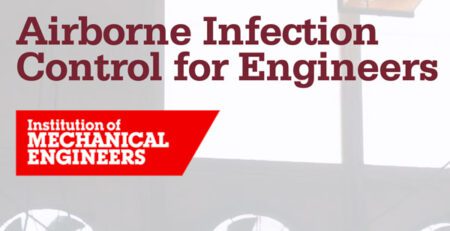Supporting the Property & Construction Sectors to deliver compliant, infection resilient new buildings and retrofit ventilation upgrades for existing facilities with germicidal UV-C (as the Jan 2022 Building Regs.)
PP-L Biosafety design germicidal UV-C systems to disinfect the air, safely and without chemicals, to create infection resilient environments. Germicidal UV-C is now the preferred design solution route for new buildings and refurbishment or retrofits into existing HVAC systems to comply with the if one wants to use recirculated air for economical ventilation within spaces and comply with the new regulations.

Paul Waldeck who is Technical Director at PPL-Biosafety, a specialist firm that designs and provides solutions that create infection resilient buildings, says that he is mindful of the economic, high energy, engineering plant, and operational concerns of attempting to deploy HEPA Filters for protecting new buildings from pathogens, let alone, the practical impossibilities of attempting to retrofit these into existing buildings without disproportionate investment and operational costs.
The next option is full fresh air ventilation systems at much faster rates than most are familiar with. Again, cost and Net Zero are the issues here. But it is economical and safe to recirculate air back into rooms when UV-C systems are designed and installed within the HVAC by competent professionals.”
Now looking at the new Building Regulations, whilst the prime reference sector is offices, the same principles for infection control apply to all non-domestic buildings and one must also consider the various statutory instruments for compliance with Health & Safety legislation too. The latter is important for CDM Professionals particularly now the requirements are clear in the new Building Regs.
The Building Regulations Part F – Ventilation (as amended- January 2022)
The main clause which is one of the most major changes in terms of ventilation strategy in decades is:
“Recirculation of air within ventilation systems in offices
1.37 Ventilation systems that, under normal operation, recirculate air between more than one space, room, or zone should also be able to operate in a mode that reduces the risk of the transmission of airborne infection. This can be achieved by one or more of the following:-
- Systems capable of providing 100% outdoor air to the levels specified in paragraphs 1.32 to 1.34 to all occupiable rooms and common spaces, without recirculating air.
- Systems incorporating a UV-C germicidal irradiation system that is able to disinfect the air that is being recirculated. This type of system is commonly located within the heating, ventilation, and air conditioning (HVAC) system or ductwork.
- Systems designed so that they can incorporate HEPA filters if required, which are able to provide filtration of the recirculated air”
Paul says that his team at PPL-Biosafety uses a range of tools, including CFD modelling of the HVAC systems, to accurately design the dose of UVC needed to destroy hazardous airborne microbes. The design parameters for conventional environments typically deal with pathogens from SARS-CoV-2 (which causes COVID-19) to Influenza A (gives x 6 factors of safety vs Covid).
Paul confirms that buildings have the power to keep us well or make us sick and so one must always assess the specific environmental, occupational design parameters and risks that are appropriate for the end user’s specific environments e.g. for many food factories, fungal spores are the priority design microbe because it requires much more UVC dose to inactivate it, than the current coronavirus clade.

Critical Design Parameters for Germicidal UVC Systems
The key headline considerations for designing a suitable UVc disinfection system for HVAC and indeed, any space are as follows:
- Occupational use and risks.
- Existing/Proposed Ventilation Strategy/Installations
- Target Microbes/Pathogens.
- Microbe inactivation energy is based upon its airborne state. (Beware!)
- Disinfection design level on the first pass of the airflow past the UVC lamps.
- Temperature Range.
- Humidity Range.
- Lamp Ingress Protection rating against moisture ingress.
- Air velocity in duct. (Microbe exposure time, ideally is 0.25sec)
- Type of lamps – twin-walled quartz anti-static glass for HVAC induct.
- The type of UV is to be germicidal, ideally 254nm or as close as practicable.
- Lamp energy consumption – less than 40W is ideal.
- Lamp UVc flux or emission energy level.
- UVc flux level at 70% emitter strength – the design energy.
- Position of UV lamps (AHU, Duct, Filters, heating & cooling coils, condensate pans)
- Arrangement and number of lamps.
- Appropriate Design equations
- Agree on all of the above as part of the Ventilation Strategy.
- Redundancy and safety failsafe.
- Agree on CDM regime for installation, commissioning, ease & safety of inspection access, maintenance, and decommissioning at 70% lamp life.
The above are typical for conventional settings but if one is considering mitigating or indeed, preventing, much higher levels of micro-biological risk e.g. where the extremes of BIO-CONTAINMENT or BIO-TERRORISM ATTACK are your priorities for protecting spaces and people, then many more considerations need to be added into the ventilation strategy.
PPL-Biosafety has some of the world’s leading authorities in each of the latter subject matter areas who can support any range of normal or sensitive End User Requirements to protect people, places and create resilience.
Non-Ducted Recirculated HVAC System e.g., Fan-coil Units
Fan coil units (FCU’s) consist of only a fan and a heating or cooling element, are located within the space they are serving, and are generally not connected to ductwork. They typically are deployed to just to heat, cool and recirculate internal air, in which case, a separate ventilation system is normally deployed too which can introduce a proportion of ‘fresh’ air that is mixed with the recirculated air. This ventilation solution is commonplace because it is very economical. This is no longer permitted under the new Regulations, unless appropriate air filtration with HEPA or disinfection with germicidal UVc.
PPL-Biosafety has lay-in grid air cleaning units that provide both HEPA and UVc which can be configured with FCU’s.


Computational Fluid Dynamics (CFD)
Computational Fluid Dynamics (CFD) modelling can be used to simulate the aerosols produced by people in a facility, as well as providing a visual representation of how they move and spread a part of the airflow and overall ventilation system design.
The use of these modelling methods allows us to suggest optimized solutions to help drastically reduce SBS and airborne pathogenic transmission risk between people not just within a building but also transport modes.
What about other Mitigations Technologies beyond Fresh Air, HEPA or UVC
The fact that these new Building Regulations, the Health & Safety Executive guidance (UK Regulator), as is common elsewhere, do not endorse or support the use of alternative technologies such as plasma, bio-polar ionization, or ozone systems within these new standards for occupied buildings, speak volumes.
In conclusion, higher quantities of clean outside air, coupled with HEPA, and crucially, UVC germicidal filters are proven “old-tech” that are safe, and compliant. The correct design, installation and maintenance of such new internal air quality improvement techniques will change the health, safety, and welfare for occupants within the built environment positively for decades to come whilst creating pandemic resilience.
Ends.
For Technical queries contact: paul.waldeck@ppl-biosafety.com
For Sale enquiries contact: enquiries@ppl-biosafety.com
For useful information and Useful Ventilation external links:
https://www.hse.gov.uk/coronavirus/equipment-and-machinery/air-conditioning-and-ventilation/index.htm
https://www.cdc.gov/coronavirus/2019-ncov/community/ventilation.html
https://www.ashrae.org/file%20library/technical%20resources/covid-19/i-p_a19_ch62_uvairandsurfacetreatment.pdf
https://www.gov.uk/government/publications/ventilation-approved-document-f





Leave a Reply